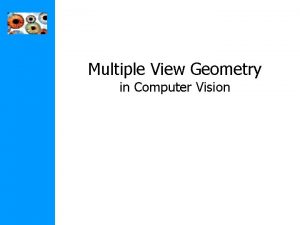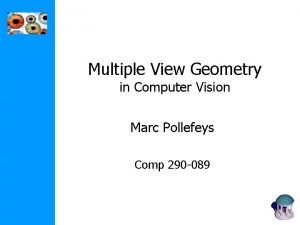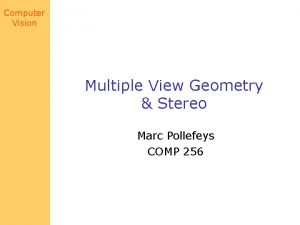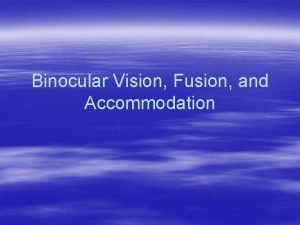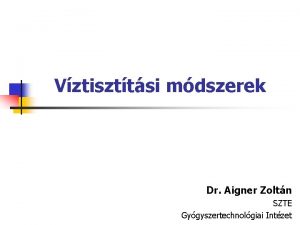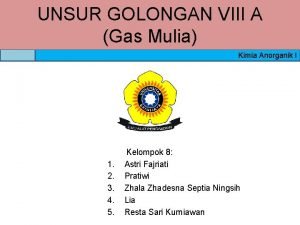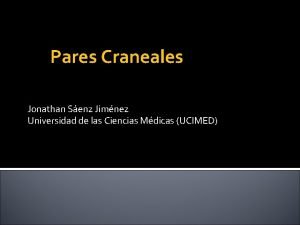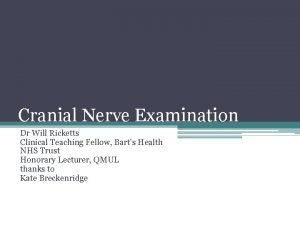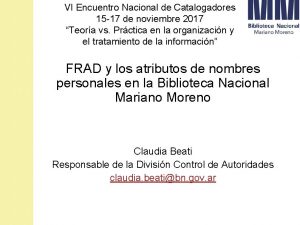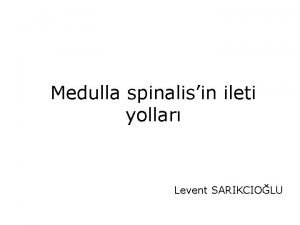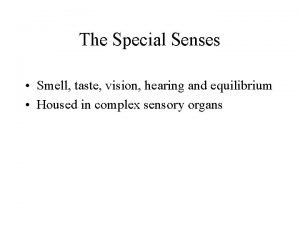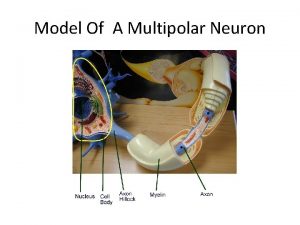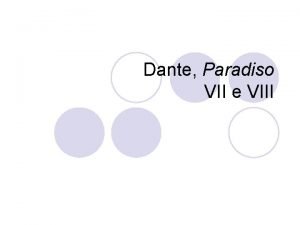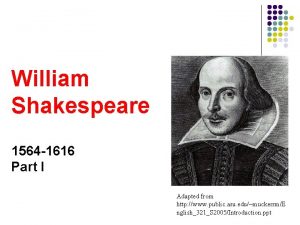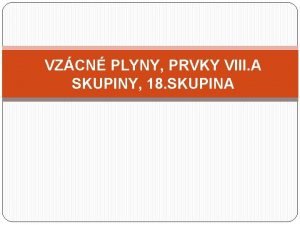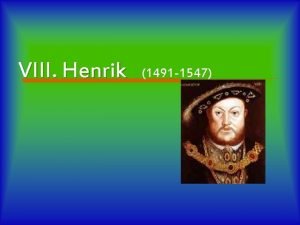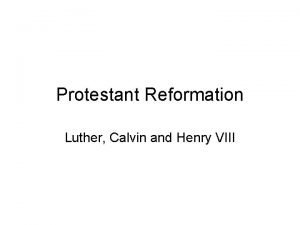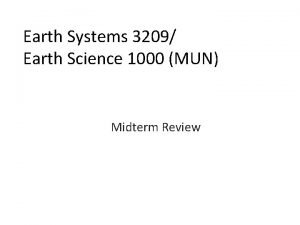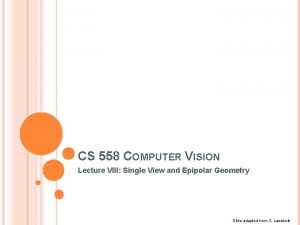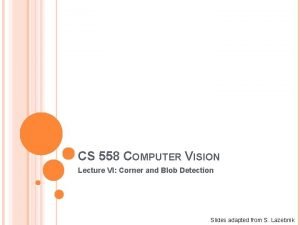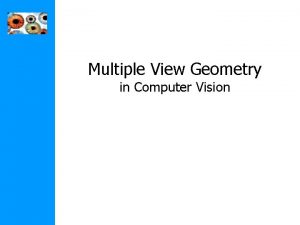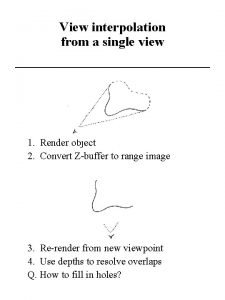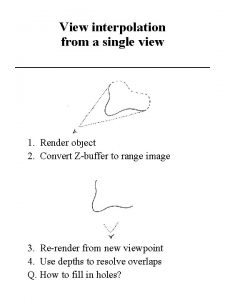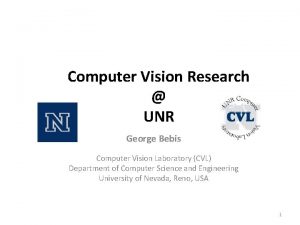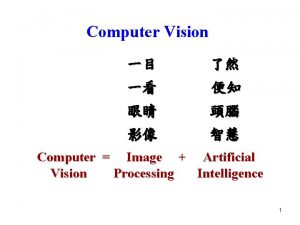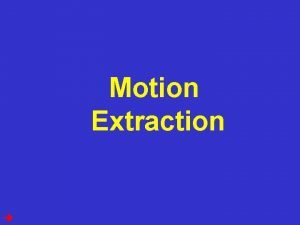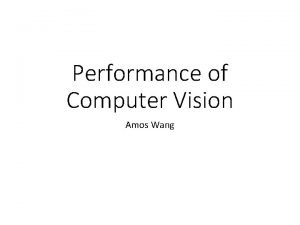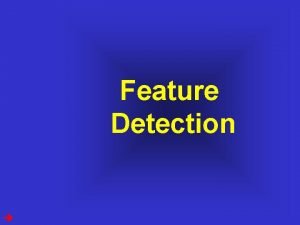CS 558 COMPUTER VISION Lecture VIII Single View



























































- Slides: 59

CS 558 COMPUTER VISION Lecture VIII: Single View and Epipolar Geometry Slide adapted from S. Lazebnik

OUTLINE Single view geometry Epiploar geometry

SINGLE-VIEW GEOMETRY Odilon Redon, Cyclops, 1914

OUR GOAL: RECOVERY OF 3 D STRUCTURE • Recovery of structure from one image is inherently ambiguous X? x X?

OUR GOAL: RECOVERY OF 3 D STRUCTURE • Recovery of structure from one image is inherently ambiguous

OUR GOAL: RECOVERY OF 3 D STRUCTURE • Recovery of structure from one image is inherently ambiguous

AMES ROOM http: //en. wikipedia. org/wiki/Ames_room

OUR GOAL: RECOVERY OF 3 D STRUCTURE • We will need multi-view geometry

RECALL: PINHOLE CAMERA MODEL • • Principal axis: line from the camera center perpendicular to the image plane Normalized (camera) coordinate system: camera center is at the origin and the principal axis is the z-axis

RECALL: PINHOLE CAMERA MODEL

PRINCIPAL POINT py px • • Principal point (p): point where principal axis intersects the image plane (origin of normalized coordinate system) Normalized coordinate system: origin is at the principal point Image coordinate system: origin is in the corner How to go from normalized coordinate system to image coordinate system?

PRINCIPAL POINT OFFSET principal point: py px

PRINCIPAL POINT OFFSET principal point: calibration matrix

PIXEL COORDINATES Pixel size: mx pixels per meter in horizontal direction, my pixels per meter in vertical direction pixels/m m pixels

CAMERA ROTATION AND TRANSLATION • coords. of point in camera frame In general, the camera coordinate frame will be related to the world coordinate frame by a rotation and a translation coords. of camera center in world frame coords. of a point in world frame (nonhomogeneous)

CAMERA ROTATION AND TRANSLATION In non-homogeneous coordinates: Note: C is the null space of the camera projection matrix (PC=0)

CAMERA PARAMETERS • Intrinsic parameters � Principal point coordinates � Focal length � Pixel magnification factors � Skew (non-rectangular pixels) � Radial distortion

CAMERA PARAMETERS • Intrinsic parameters � Principal point coordinates � Focal length � Pixel magnification factors � Skew (non-rectangular pixels) � Radial distortion • Extrinsic parameters � Rotation system and translation relative to world coordinate

CAMERA CALIBRATION Source: D. Hoiem

CAMERA CALIBRATION • Given n points with known 3 D coordinates Xi and known image projections xi, estimate the camera parameters Xi xi

CAMERA CALIBRATION: LINEAR METHOD Two linearly independent equations

CAMERA CALIBRATION: LINEAR METHOD • • P has 11 degrees of freedom (12 parameters, but scale is arbitrary) One 2 D/3 D correspondence gives us two linearly independent equations Homogeneous least squares 6 correspondences needed for a minimal solution

CAMERA CALIBRATION: LINEAR METHOD • Note: for coplanar points that satisfy ΠTX=0, we will get degenerate solutions (Π, 0, 0), (0, Π, 0), or (0, 0, Π)

CAMERA CALIBRATION: LINEAR METHOD • • Advantages: easy to formulate and solve Disadvantages � Doesn’t directly tell you camera parameters � Doesn’t model radial distortion � Can’t impose constraints, such as known focal length and orthogonality • Non-linear methods are preferred � Define error as difference between projected points and measured points � Minimize error using Newton’s method or other nonlinear optimization Source: D. Hoiem

MULTI-VIEW GEOMETRY PROBLEMS • Structure: Given projections of the same 3 D point in two or more images, compute the 3 D coordinates of that point ? Camera 1 R 1, t 1 Camera 2 R 2, t 2 Camera 3 R 3, t 3 Slide credit: Noah Snavely

MULTI-VIEW GEOMETRY PROBLEMS • Stereo correspondence: Given a point in one of the images, where could its corresponding points be in the other images? Camera 1 R 1, t 1 Camera 2 R 2, t 2 Camera 3 R 3, t 3 Slide credit: Noah Snavely

MULTI-VIEW GEOMETRY PROBLEMS • Motion: Given a set of corresponding points in two or more images, compute the camera parameters Camera 1 R 1, t 1 ? Camera 2 R 2, t 2 ? ? Camera 3 R 3, t 3 Slide credit: Noah Snavely

TRIANGULATION • Given projections of a 3 D point in two or more images (with known camera matrices), find the coordinates of the point X? x 1 O 1 x 2 O 2

TRIANGULATION • We want to intersect the two visual rays corresponding to x 1 and x 2, but because of noise and numerical errors, they don’t meet exactly R 2 x 1 O 1 R 1 X? x 2 O 2

TRIANGULATION: GEOMETRIC APPROACH • Find shortest segment connecting the two viewing rays and let X be the midpoint of that segment X x 1 O 1 x 2 O 2

TRIANGULATION: LINEAR APPROACH Cross product as matrix multiplication:

TRIANGULATION: LINEAR APPROACH Two independent equations each in terms of three unknown entries of X

TRIANGULATION: NONLINEAR APPROACH Find X that minimizes X? x’ 1 x 1 O 1 x’ 2 x 2 O 2

TWO-VIEW GEOMETRY

EPIPOLAR GEOMETRY X x x’ • Baseline – line connecting the two camera centers • Epipolar Plane – plane containing baseline (1 D family) • Epipoles = intersections of baseline with image planes = projections of the other camera center

THE EPIPOLE Photo by Frank Dellaert

EPIPOLAR GEOMETRY X x x’ • Baseline – line connecting the two camera centers • Epipolar Plane – plane containing baseline (1 D family) • Epipoles = intersections of baseline with image planes = projections of the other camera center • Epipolar Lines - intersections of epipolar plane with image planes (always come in corresponding pairs)

EXAMPLE: CONVERGING CAMERAS

EXAMPLE: MOTION PARALLEL TO IMAGE PLANE

EXAMPLE: MOTION PERPENDICULAR TO IMAGE PLANE

EXAMPLE: MOTION PERPENDICULAR TO IMAGE PLANE

EXAMPLE: MOTION PERPENDICULAR TO IMAGE PLANE e’ e Epipole has same coordinates in both images. Points move along lines radiating from e: “Focus of expansion”

EPIPOLAR CONSTRAINT X x • x’ If we observe a point x in one image, where can the corresponding point x’ be in the other image?

EPIPOLAR CONSTRAINT X X X x x’ x’ x’ • Potential matches for x have to lie on the corresponding epipolar line l’. • Potential matches for x’ have to lie on the corresponding epipolar line l.

EPIPOLAR CONSTRAINT EXAMPLE

EPIPOLAR CONSTRAINT: CALIBRATED CASE X x • • • x’ Assume that the intrinsic and extrinsic parameters of the cameras are known We can multiply the projection matrix of each camera (and the image points) by the inverse of the calibration matrix to get normalized image coordinates We can also set the global coordinate system to the coordinate system of the first camera. Then the projection matrix of the first camera is [I | 0].

EPIPOLAR CONSTRAINT: CALIBRATED CASE X = RX’ + t x x’ t R The vectors x, t, and Rx’ are coplanar

EPIPOLAR CONSTRAINT: CALIBRATED CASE X x x’ Essential Matrix (Longuet-Higgins, 1981) The vectors x, t, and Rx’ are coplanar

EPIPOLAR CONSTRAINT: CALIBRATED CASE X x • • • x’ E x’ is the epipolar line associated with x’ (l = E x’) ETx is the epipolar line associated with x (l’ = ETx) E e’ = 0 and ETe = 0 E is singular (rank two) E has five degrees of freedom

EPIPOLAR CONSTRAINT: UNCALIBRATED CASE X x • • x’ The calibration matrices K and K’ of the two cameras are unknown We can write the epipolar constraint in terms of unknown normalized coordinates:

EPIPOLAR CONSTRAINT: UNCALIBRATED CASE X x x’ Fundamental Matrix (Faugeras and Luong, 1992)

EPIPOLAR CONSTRAINT: UNCALIBRATED CASE X x • • • x’ F x’ is the epipolar line associated with x’ (l = F x’) FTx is the epipolar line associated with x (l’ = FTx) F e’ = 0 and FTe = 0 F is singular (rank two) F has seven degrees of freedom

THE EIGHT-POINT ALGORITHM x = (u, v, 1)T, x’ = (u’, v’, 1)T Minimize: under the constraint F 33 = 1

THE EIGHT-POINT ALGORITHM • Meaning of error • sum of Euclidean distances between points xi and epipolar lines F x’i (or points x’i and epipolar lines FTxi) multiplied by a scale factor Nonlinear approach: minimize

PROBLEM WITH EIGHT-POINT ALGORITHM

PROBLEM WITH EIGHT-POINT ALGORITHM Poor numerical conditioning Can be fixed by rescaling the data

THE NORMALIZED EIGHT-POINT ALGORITHM (Hartley, 1995) • • Center the image data at the origin, and scale it so the mean squared distance between the origin and the data points is 2 pixels Use the eight-point algorithm to compute F from the normalized points Enforce the rank-2 constraint (for example, take SVD of F and throw out the smallest singular value) Transform fundamental matrix back to original units: if T and T’ are the normalizing transformations in the two images, than the fundamental matrix in original coordinates is TT F T’

COMPARISON OF ESTIMATION ALGORITHMS 8 -point Normalized 8 -point Nonlinear least squares Av. Dist. 1 2. 33 pixels 0. 92 pixel 0. 86 pixel Av. Dist. 2 2. 18 pixels 0. 85 pixel 0. 80 pixel

FROM EPIPOLAR GEOMETRY TO CAMERA CALIBRATION • • • Estimating the fundamental matrix is known as “weak calibration” If we know the calibration matrices of the two cameras, we can estimate the essential matrix: E = KTFK’ The essential matrix gives us the relative rotation and translation between the cameras, or their extrinsic parameters
 Bu cs 558
Bu cs 558 Ece 558
Ece 558 558 divided by 62
558 divided by 62 Structured light
Structured light Multiple view geometry
Multiple view geometry Quadrifocal
Quadrifocal Multiple view geometry in computer vision
Multiple view geometry in computer vision 01:640:244 lecture notes - lecture 15: plat, idah, farad
01:640:244 lecture notes - lecture 15: plat, idah, farad Development of binocular single vision
Development of binocular single vision Sisd processor
Sisd processor Dataxin
Dataxin Waiting line management
Waiting line management Computer security 161 cryptocurrency lecture
Computer security 161 cryptocurrency lecture Computer-aided drug design lecture notes
Computer-aided drug design lecture notes Computer architecture notes
Computer architecture notes Microarchitecture vs isa
Microarchitecture vs isa Aqua destillata vs aqua purificata
Aqua destillata vs aqua purificata Pembuatan unsur neon
Pembuatan unsur neon Henry viii family tree
Henry viii family tree Vestibulo coclear
Vestibulo coclear Henry viii beheaded wives
Henry viii beheaded wives King louis xvi family tree
King louis xvi family tree Ato de supremacia de henrique viii
Ato de supremacia de henrique viii Cn viii test
Cn viii test Code of ethics for professional teachers article 7
Code of ethics for professional teachers article 7 Reforma luterana consequências
Reforma luterana consequências Henry viii great matter
Henry viii great matter Henry viii banquet menu
Henry viii banquet menu Grupo viii a de la tabla periodica
Grupo viii a de la tabla periodica Viii domingo tiempo ordinario ciclo c
Viii domingo tiempo ordinario ciclo c Domingo viii tiempo ordinario ciclo c
Domingo viii tiempo ordinario ciclo c Henry viii definition ap world history
Henry viii definition ap world history Roma siglo viii a.c
Roma siglo viii a.c Viii encuentro nacional de catalogadores
Viii encuentro nacional de catalogadores Tr rubrospinalis
Tr rubrospinalis Merkantilisme reformasi gereja
Merkantilisme reformasi gereja Csric viii
Csric viii Henry viii divorce catherine of aragon
Henry viii divorce catherine of aragon The six wives of henry viii
The six wives of henry viii Cn viii
Cn viii Raport evaluare nationala
Raport evaluare nationala Cn viii
Cn viii Faustino viii
Faustino viii Canto viii paradiso
Canto viii paradiso Cn viii
Cn viii King henry viii gardena
King henry viii gardena Prvky 18. skupiny
Prvky 18. skupiny Viii henrik feleségei
Viii henrik feleségei Henry viii deathbed painting
Henry viii deathbed painting Faustino viii
Faustino viii Luther calvin and henry viii
Luther calvin and henry viii Roman numerals n
Roman numerals n Theocracy def
Theocracy def Henryk viii
Henryk viii Jnc 8
Jnc 8 Viii
Viii Henry viii great matter
Henry viii great matter Henry viii foreign policy 1509-1529
Henry viii foreign policy 1509-1529 O dinheiro enquanto fonte de corrupção analise
O dinheiro enquanto fonte de corrupção analise Earth systems 3209
Earth systems 3209




